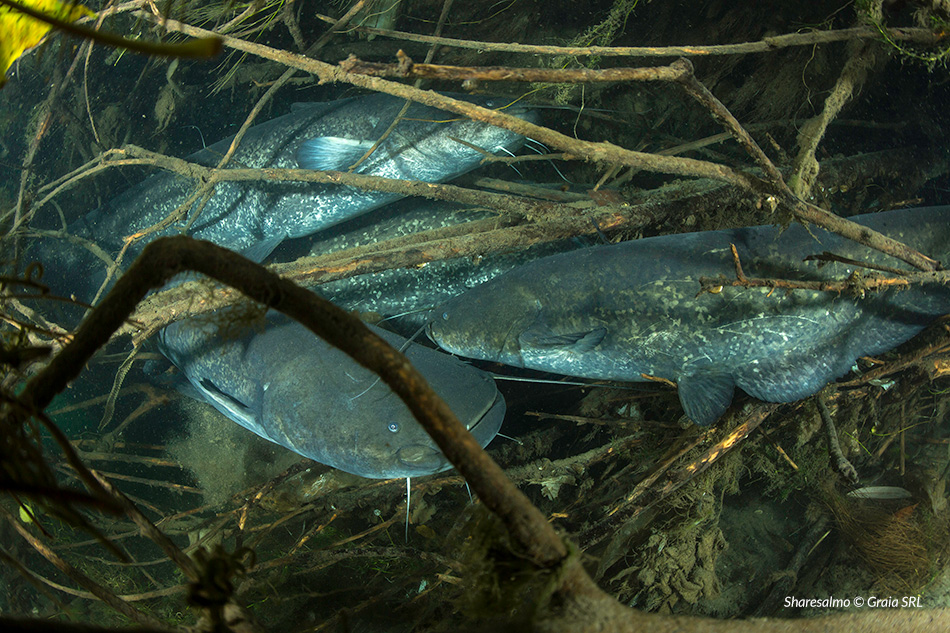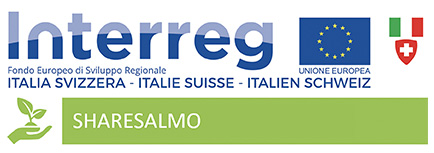THE WELS CATFISH
WELS CATFISH (Silurus glanis)
The Wels catfish (Siluridae family) is a native species of the Centre and East Europe and the North-Western Asia. Because of man behaviour, it is distributed also outside its home range: all over Europe, Italy included, and in other Asian lands. The Wels catfish lives in different types of water courses. It lives in rivers and lakes, in both running or calm water, it is not a demanding species and does not require high water quality. It has got a long body, cylindrical in the anterior part and compressed in the posterior one. The head is big and flat, the mouth is large, the eyes are small. It has got barbs. Its anal fin is elongated. The skin is greyish, greenish and whitish, it hasn’t got flakes and it is covered by mucus. The Wels catfish is a predator: it eats especially fish, but the bigger specimens also eat water birds and little mammals. Young Wels catfish eat primarily invertebrates. During the inactivity period (winter) a lot of specimens can join together in stumps and flooder shelters. The reproductive period of the species occurs in spring: from April to June male specimens dig a nest in the stream bed and defend it from predators. In the areas where this species has been introduced, it has spread and has colonized a lot of water courses, often replacing native predators.
The Wels catfish was introduced in Italy for fishing. First news about its presence came from Adda River in the 50s. In Maggiore and Como lakes the presence and reproduction of Wels catfish is known by years. In Lugano Lake the species has appeared recently with a low number of specimens and there is not information about its reproduction. The species represents one of the main threats to native salmonids, for this reason it is important to expand knowledge about its distribution and reproduction to manage it with more responsibility.

THREAT DESCRIPTION
Wels catfish is an invasive alien species in Italy. It adapts to our freshwater, where it reproduces, it reaches big dimension in a short time, it is active mainly at night (when native fish are not active), it is a voracious predator, it eats everything and when it reaches a certain size it has not competitors or predators. All these features allow the species to survive, reproduce and spread in the water courses in which it had been introduced, making Wels catfish a menace for native fish species. Where Wels catfish is present, native species decrease. Wels catfish is considered the mainly menace to native salmonids in Sharesalmo area, for this reason some project activities are about Wels catfish.
ACTIVITIES TO REMOVE THE WELS CATFISH
The current and potential breeding areas of Wels catfish are recorded and characterised during the reproductive period in Maggiore and Como lakes, while in Lugano Lake the potential breeding areas are recorded to verify their use. A sheet is filled out for each area, where its features are specified (for instance type of substrate, type of vegetation, water depth) and the presence of fish and nests are verified. Then a suitability class for the breeding is assigned to every area. The suitability classes for Wels catfish breeding are low, medium-low, medium, medium-high, high. Areas that obtain classes from medium to high are better analysed. At the end of the project, maps of breeding are set up. These maps will give information about the invasive species and will be used to better manage efforts against Wels catfish spreading.
Also, the containment of the Wels catfish in Maggiore Lake is included in Sharesalmo project. This activity is repeated during years. The goals of the project are the decrease of specimens and the definition of the better techniques of Wels catfish reduction in lakes.
Information obtained during the project will be used to create cross-border strategies against Wels catfish spreading in Pre-Alpine lakes and to write Good Practices of Wels catfish management, available in other projects.
RESULTS
Mapping and characterisation of breeding areas
During the first project years, the current breeding areas in Maggiore and Como lakes have been identified, thanks to anglers and local authorities, while new areas have been assumed by using cartography. Regarding Como Lake, the cartography and anglers reporting have been used to choose potential breeding areas. Then the chosen areas have been examined by boat, they have been characterised using various parameters and
the suitability class of breeding have been assigned. 10 campaigns have been done. A database containing the collected information and a map have been set up for every lake. The areas and their suitability class of breeding are indicated in the maps. 176 areas have been characterized, 95 of which obtained a medium or upper class. Specimens and nests have not been observed in the areas. The areas that have obtained a medium to high class are better analysed.
Fish reduction
Containment campaigns have been set up in Maggiore Lake during these years. This activity removed some tons of Wels catfish from the lake.


